What The USAF Sees In Its Crystal Ball
(Note: The following comes from the USAF Transformation
Flight Plan, a living document designed to chart the service's
future in the near-, mid-, and long-term.
--ed.)
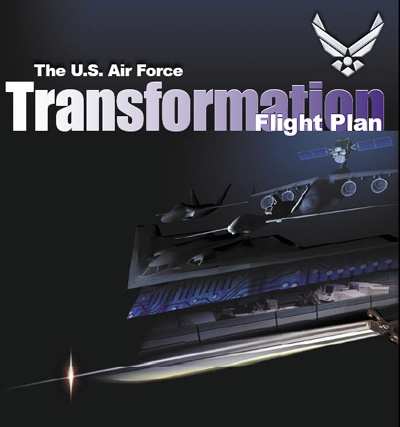
- Active Denial System ACTD
This nonlethal antipersonnel weapon transmits high power
microwave energy that is absorbed in the first layers of skin,
producing a near-instantaneous, severely painful sensation. ADS
will not cause long-term damage to the targets. Research is ongoing
on both land and airborne variants of ADS.
- Adaptive Battlespace Awareness ACTD
Will demonstrate the potential of the Global Command and Control
System Common Operating Picture to provide relevant information to
support situational awareness, decision-making, execution, and
planning for future operations.
- Adaptive Joint C4ISR Node ACTD
Will integrate, demonstrate, and transition a single,
multi-mission, morphable radio frequency system that provides
seamless interoperable communications, signals intelligence,
electronic, and information capabilities.
-
 Advanced Extremely High Frequency
System
Advanced Extremely High Frequency
System
Will allow secure, jam-resistant, worldwide, satellite-based
communications independent of ground relay stations and
distribution networks.
- Advanced Mobility Concept Aircraft
Would provide world wide, all-weather, high speed, direct
delivery to the battlefield with a more survivable airlifter
capable of airliner speed, oversized cargo, and short take off and
landing coupled to Autonomous Approach and Landing Guidance. This
aircraft will be able to carry the full spectrum of US Army Future
Combat Systems.
- Advanced Mobility Tanker (KC-X)
Would be a long-range, long-endurance tanker that can also carry
significant cargo loads. Its range would allow bombers and tankers
to leave CONUS simultaneously and eliminate the need to pre-deploy
tankers, greatly enhancing rapid global mobility.
- Advanced Propulsion Systems
Would provide Mobility Air Forces with advance propulsion
systems featuring a quantum leap in specific fuel consumption of
hydro-carbon based fuels, far greater ranges with less reliance
upon tanker forces, and significant increases in the efficiencies
of rapid mobility capability.
- Advanced Situational Awareness/ Countermeasures System
Is the Air Force’s long-term vision for enhanced
situational awareness, threat detection, and radio frequency
countermeasures and threat mitigation for mobility assets to help
enable mobility assets into defended areas. The system will include
on board Precision Location and Identification Radar Warning
Receivers and an open architecture for off-datalinks (Link-16,
etc.), on- and off-board radio frequency warning systems, and
countermeasures to defeat radio frequency missile engagements. The
system features an EW processor to fuse (machine-to-machine) all
data into actionable information for a ‘two pilot’
crew.
-
 Advanced Standoff Cruise
Missile
Advanced Standoff Cruise
Missile
Would provide persistent air-to-ground operations beyond the
range of enemy IADS. It would utilize a Global Positioning
System/Inertial Navigation System to ensure precision strike and
receive mission updates and course correction information from
off-board sensors. A laser radar search sensor would enhance target
identification. Its stealthy airframe and advanced target
identification system would provide a huge tactical advantage.
- Advanced Tactical Laser ACTD
Will demonstrate a high-energy laser weapon system for precision
tactical airborne applications. This laser will provide warfighters
with ultra precision and the ability to manage precise effects on
an operator’s target of choice. It will have a range of more
than 10 km and a one second-to-kill capability.
- Advanced Tactical Targeting Technology ACTD
By sharing the measurement of radar signals, this ACTD will
leverage data from any airborne platforms, such as fighters, to
detect and locate enemy surface-to-air radars to an accuracy of 50
meters, from 50 miles away, and within ten seconds after the
enemy’s radar turns on. This would enable transformational
persistent ISR capabilities to the battlespace without reliance on
current high-density, low-demand platforms. Using data links to
connect them to strike platforms, every sensor would become a
shooter or linked to a shooter.
- Agile Force Accountability
Would significantly improve force accountability through the
development of a single software suite and classified database
(along with scanner technology) for deployed military
personnel.
- Agile Transportation (AT 21) ACTD
ACTD sponsored by US Transportation Command that will
demonstrate total visibility of all transportation requirements,
available lift assets, personnel, and equipment moving to and
within the various theaters of operation. Advanced scheduling
decision support tools will be used for mode determination and
optimization of intertheater lift assets, resulting in reduced
force closure times and a smaller theater logistics footprint.
- Air and Space Operations Center
The Air Force has designated the Air and Space Operations Center
as a weapon system to provide the Joint Force Air and Space
Component Commander a standardized capability to command and
control air and space forces. This action will greatly enhance
horizontal integration and provide a much-improved capability to
support joint operations with planning, tasking, command and
control, data fusion, and near real-time common operating pictures
of the battlespace.
- Air Expeditionary Force Weapon
Would be a small, low cost standoff weapon using the Small
Diameter Bomb concept with a 250 pound warhead and 500 nautical
mile range that could be launched from a variety of platforms.
- Air Force Network Operations and Security Center
Will provide a single command and control authority over
information flow in AF by uniting the nine MAJCOM Network
Operations and Security Centers. It will provide AF one
organization to handle both service specific and joint computer
responsibilities.
- Air Force Satellite Control Network Upgrades
The Air Force Satellite Control Network provides the earth and
space connections required to launch, initialize, operate, and
maintain all military satellites and recover critical warfighter
data. It is being significantly enhanced over the next ten years to
provide DoD-level network assured access from distributed users to
and from space assets with a new dual band capability for the
widest compatibility among all DoD space systems.
- Air Force Transformation Center
Previously, an AOC used its own unique hardware, software, and
servers that were often incompatible with other systems in other
AOCs. The Air Force Transformation Center (formerly the CAOC-X)
will ensure that the latest new technologies to achieve the
capability to provide the commander a clear, coherent, real-time
picture of the battlespace are incorporated into the global and
theater AOCs in a timely and standardized manner.
- Air Force WMD Emergency Response Program
This pilot program provides selected bases with WMD equipment,
training and exercises. The program is designed to enhance
cooperation/coordination between key players from the base and
federal/state/local/host nation emergency responders.
Would be a dedicated, all azimuth, weather avoiding, on-demand
(within 48 hours) system capable of launching a Space Maneuver
Vehicle, Common Aero Vehicle, or a Conventional Payload Module.
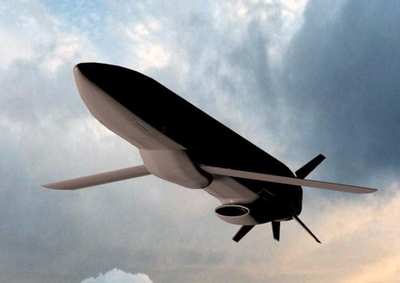
- Airborne Active Denial System
Will be an airborne application of the Active Denial System for
special operations and other missions.
Will use a high-energy laser mounted on a modified 747 aircraft
to destroy ballistic missiles in their boost phase (currently under
control of the Missile Defense Agency).
- Airborne Networking Capability
Enables access to unclassified and classified email, shared
files, and applications hosted on their home station networks as
well as view live TV and participate in secure video
teleconferences from airborne platforms. The intent is to provide
an “office in the sky” and extend the Global
Information Grid into the airborne platforms. US senior leadership
enjoys this capability at present. The Air Force intends to expand
this capability to more airborne platforms.
- Air-Launched Anti-Satellite Missile
Would be a small air-launched missile capable of intercepting
satellites in low earth orbit.
Will use technology to automate the TPED process to speed the
delivery of finished intelligence to the user. It includes upgrades
such as Distributed Ground System Block 20 upgrades, Network
Centric Collaborative Targeting, Link-16, Automated
Geo-Precise-Positioning of sensors, and Computer Aided Target
Detection.
Will permit the refueling of manned as well as unmanned air
vehicles on fueling tracks obscured by clouds. This would ensure
that mobility, strike, and ISR operations would not be degraded by
weather in refueling areas.
- Autonomous Approach and Landing Guidance
Will enable mobility operations to be conducted regardless of
weather conditions and independent of ground based navigation aids
by allowing mobility aircraft to land on normal surfaced runways as
well as unimproved landing zones in adverse weather (to include
smoke, fog, rain, and snow) conditions.
Would provide real-time vital sign information to individuals,
first aid givers, and medical personnel to enable rapid self-aid
and buddy care and triage of casualties entering the medical
system.
Would track individual location and vital signs to reduce
fratricide, rapidly recover ill or injured airmen, and detect
potentially harmful exposures. B-X Bomber Would be a stealthy
long-range, supersonic bomber with a 5000 nautical mile unrefueled
range.
-
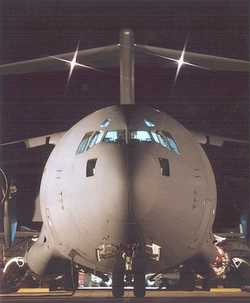 C-17
C-17
The C-17 has transformed the way the Air Force does mobility by
blending strategic and tactical airlift missions into one to better
support the warfighter. It can also fly intercontinental missions,
operate into short, semi-prepared landing zones, move patients,
outsized cargo, and complete airdrops. Equipped with defensive
systems, it can move cargo and passengers over long and short
distances, from ports of embarkation directly to assault zones in
the battle area—avoiding the delays associated with
transferring cargo to theater airlift aircraft for final delivery
to the combat forces.
- Centralized Intermediate Repair Facilities
Key element of the agile combat support strategy to
significantly improve support to warfighting commanders. Regional
repair facilities are established based on critical needs to reduce
deployment footprint, increase deployment flexibility and speed,
and reduce overall maintenance manpower requirements.
- Combat Information Transport System
Will provide a network centric, fiber-optic system to move,
process, and protect all Air Force information.
- Combatant Commanders Integrated Command and Control System
Will provide the command and control of current and future space
forces and space situation awareness via the Space common
operational picture.
- Command and Control Constellation
Will enable the horizontal integration of ground, air, and space
sensors and battle management platforms such as strike aircraft and
ground troops.
Will be an unpowered, maneuverable, hypersonic glide vehicle
deployed from a possible range of delivery vehicles such as an
expendable or reusable small launch vehicle to a fully reusable
Space Operations Vehicle. It will guide and dispense conventional
weapons, sensors, or other payloads worldwide from and through
space within one hour of tasking. It would be able to strike a
spectrum of targets, including mobile targets, mobile time
sensitive targets, strategic relocatable targets, or fixed hard and
deeply buried targets. The Common Aero Vehicle’s speed and
maneuverability would combine to make defenses against it extremely
difficult.
- Communication/Navigation Outage Forecasting System ACTD
Will demonstrate the ability to combine data from ground- and
sea-based sensors to provide real-time products predicting when
ionospheric disturbances will affect satellite communications and
navigation systems, which will help distinguish between an attack
on space systems and natural phenomenon.
- Compact Environmental Anomaly Sensor II ACTD
Will demonstrate the ability of on-board space environment
sensor suites to reduce satellite downtime and assist in ruling out
hostile attack as the cause of satellite malfunction and provide
warnings of dangerous space environment conditions.
- Condition Based Maintenance
A new support concept that would exploit engineering and
technical knowledge combined with actual failure experience and
condition data that would move toward predictive maintenance
practices vice reactive practices. Key to this capability are a
robust systems engineering process, exploitation tools based on the
EDW, serial number tracking of key components, and on board
diagnostics.
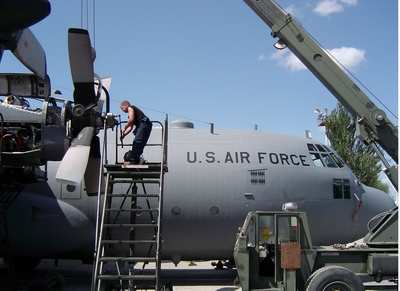
- Cooperative Persistent Surveillance Strike Vehicle
Would be a light weight search and destroy system to perform
near all-weather surveillance and attack.
- Counter Satellite Communications System
Will provide the capability to deny and disrupt an
adversary’s space-based communications and early warning.
- Counter Surveillance and Reconnaissance System
Will provide offensive counterspace counter
surveillance/reconnaissance weapon acquisition program to deny,
disrupt, and degrade adversary space-based surveillance and
reconnaissance systems.
Will rapidly insert large numbers of special operations forces
or other small units over long distances with its high speed and
unique capabilities.
Will dramatically reduce the footprint of medical expeditionary
forces by eliminating the need to resupply liquid oxygen to
deployed medical forces.
- Deployable Theater Information Grid
Will operate as a deployable, mobile information dissemination
grid generating increased combat power through information
superiority by integrating networks, sensors, decision-makers, and
shooters. It will also enable commanders to dynamically plug and
play sensors, engagement systems, weapons, command and control, and
support capabilities into task-organized packages across the combat
theater.
- Deployment Readiness System
Web-based solution to significantly reduce deployment scheduling
time, track personnel training requirements and status, and
facilitate the management of Unit Type Code qualification
throughout the Air Force.
- Digital Imagery Request and Distribution System (BRITE)
Will give US forces national and theater imagery faster.
- Distributed Common Ground System
Will be an open architecture, network-centric system that will
enable the support of multiple, simultaneous, worldwide operations
from in garrison and through scalable, modular system deployments.
It will be interoperable with spaceborne, airborne, and surface ISR
collection assets and intelligence producers and it will be able to
access intelligence databases from these ISR resources to optimize
ISR capabilities. As a key component of the GIG, this system will
provide the backbone through which disparate ISR assets will be
horizontally integrated. It will transform the Air Force’s
ISR infrastructure to a net-centric enterprise.
- Enhanced Human Performance
Would significantly improve cognition, strength, endurance, and
perception of individuals.
- Space Global Laser Engagement (EAGLE) Airship Relay
Mirrors
Will significantly extend the range of both the Airborne Laser
and Ground-Based Laser by using airborne, terrestrial, or
space-based lasers in conjunction with space-based relay mirrors to
project different laser powers and frequencies to achieve a broad
range of effects from illumination to destruction.
- Expeditionary Medical Support System
Would significantly increase the theater preventive, primary,
and emergent care capabilities of expeditionary medical platforms
and systems while dramatically reducing airlift requirements and
the theater medical footprint.
- Extended Range Strike Aircraft
Would be a modified 747-400 capable of standoff strikes against
hardened and deeply buried targets while beyond the range of
theater air defenses as well as counter-CBRNE and SEAD missions. A
simultaneous attack by 20 aircraft could destroy 1500 targets in
less than 15 minutes.
- eXtensible Markup Language
Will be a key enabler to the free exchange of information
between systems and their associated databases.
In addition to its revolutionary first-look, first-launch, and
first-kill air-to-air capabilities, the F/A-22’s combination
of all-aspect stealth, supercruise speed, and integrated avionics
that enable it to engage mobile ground targets in any weather will
be essential for the United States to penetrate the next two
generations of rapidly advancing enemy air defenses and clear the
way for follow-on joint forces day or night. These capabilities
will also track, rapidly close in, and engage enemy cruise
missiles. The F/A-22 is also pioneering the capability for one
platform to connect all the links the “kill chain”:
find-fix-track-target-engage-assess. Its on-board sensors and
communications systems will detect and track enemy systems,
allowing immediate self-targeting or engagement by other platforms
that receive the battlespace picture on a shared network, followed
by an immediate assessment of effects.
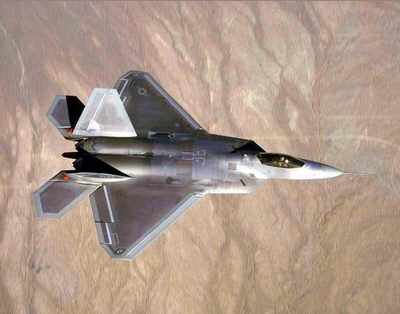
- Family of Interoperable Operational Pictures
A joint program with new funding provided by OSD that will close
the seams between existing legacy C4ISR systems and extend the
capability of systems under development in order to exploit the
full data collection and management abilities of current C4ISR
assets. Its goal is to achieve a Common Relevant Operational
Picture: an all-source picture of the battle space containing
actionable, decision-quality, information to the warfighter through
a fusion of existing databases. It will achieve this by
implementing data sharing and fusion among heterogeneous,
stovepiped systems in support of both operational and tactical
users. It will facilitate establishment of interoperability
standards and architectures to guide future acquisitions.
- Family of Small Unmanned Systems
Will provide Special Tactics personnel increased battlespace
awareness through employment of small, tactical UAVs.
-
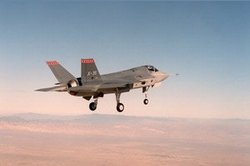 F-35
F-35
The F-35 will be a new fighter aircraft that has
transformational sensor capability that enables non-traditional ISR
and sensor integration that will help enable the transformational
capabilities of machine-to-machine integration and real-time
picture of the battlespace. It also will possess low-observable
characteristics that will enable persistent combat air support over
the future battlefield. Furthermore, F-35 will help enable the
negation of advanced enemy air defenses because it will possess the
ability to perform unrestricted operations within heavily defended
airspace.
- Full Spectrum Threat Response
Program will be how the AF will plan for, respond to, and begin
recovery from full spectrum threats at the installation and MAJCOM
level. It includes program elements such as Terrorist Weapons of
Mass Destruction Response; the Weapons of Mass Destruction Pilot
Installation Program; Joint Service Installation Pilot
Program/Guardian; Hazardous Material Emergency Response; Nuclear,
Biological, Chemical, and Conventional Defense; and non-Medical
CBRNE defense.
- Full Spectrum Threat Response Program
This program includes policy and guidance to help commanders
confront the full spectrum of physical threats and provide for the
protection of installation resources. It captures the complete
incident response cycle, from planning to response and recovery. It
includes guidelines for training, exercising, equipping, and
assessing the installation’s capability for successful
operations. It provides the Air Force approach to planning,
organizing, training, and equipping personnel and protecting the
critical infrastructures needed to accomplish the mission for the
possibility of a nuclear, biological, chemical, or conventional
enemy attack, major accident, natural disaster, or terrorist use of
weapons of mass destruction.
- Future Single Supply System
Would reengineer the AF supply processes to leverage commercial
best practices and enterprise systems. Goal would be to replace 76
current supply or supply related systems and enable single entry,
instantaneous common operating picture and real time visibility
over all AF supply assets worldwide.
Will provide a true global and fully mobile communications
architecture to DoD operators. Its satellite-based (Ka-band)
architecture transcends previous geographic limitations to allow
relatively high bandwidth transmission of mission critical data to
forces virtually anywhere in the world with relative
simplicity.
- Global Combat Support System-AF
Delivers real-time, worldwide asset, equipment, and weapon
system status. Deployed troops have praised the Air Force logistics
capabilities on the portal and said that it is the only way they
have had asset visibility and access to their logistics
applications at bare base locations. The fleet asset status tool
provides real-time status of aircraft worldwide, with drill-down
capabilities for parts and maintenance status. Additional
capabilities and tools continue to be added through spiral
development.
- Global CONOPS Synchronization
Will demonstrate ability to and benefits of sharing real-time
information among Mobility Air Force (global) and Combat Air Force
(multi-area of responsibility centric) command and control planning
and execution systems and flying assets via machine-to-machine data
exchange.
-
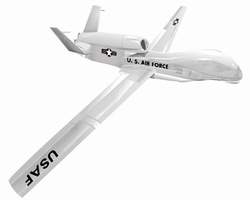 Global Hawk
Global Hawk
The Global Hawk is a high endurance UAV with an ISR payload for
intercontinental coverage. When combined with the continuous global
access of Space-Based Radar and near real-time data transfer to
multiple relevant command and control elements, the Global Hawk
will allow constant imaging or tracking of relevant mobile or fixed
surface targets in any weather conditions.
- Global Launch and Test Range
Would broaden the region over which the launch and test ranges
are able to execute Telemetry, Tracking, and Commanding during
spacelift operations as well as test and evaluation activities. It
will also support the current military spaceplane plan calling for
launches from the interior of the US, away from the coasts. Would
provide necessary Command and Control for the Space Maneuver
Vehicle and the Space Operations Vehicle. Would be a key enabler of
responsive launch and operation of new space vehicles and
refueling/repair of existing vehicles.
Will greatly expand current GPS navigation and targeting
capabilities and enhance its jam-resistance in conjunction with
anti-jam margins provided by user equipment.
Would propagate laser beams through the atmosphere to Low-Earth
Orbit satellites to provide robust defensive and offensive space
control capability.
- Ground Contingency Medical Support System
Would significantly increase the preventive, primary, emergent
care, and mass casualty management capabilities of individual
ground medical systems.
- Ground Warrior Modernization
Will standardize (with special forces) and significantly improve
the equipment used by Tactical Air Control Parties (ground spotters
for air strikes), who are critical enablers of time-critical
targeting and timely close air support in many instances.
- Guardian Urban Combat Weapon
Would be an air launched lurk and loiter reconnaissance, rotary
winged, unmanned, combat air vehicle designed for urban
warfare.
- High Powered Microwave Airborne Electronic Attack
Will develop and demonstrate an anti-electronics high powered
microwave weapon against “soft” electronic-containing
targets from an airborne platform at military significant
ranges.
- Hypersonic Cruise Vehicle
Would operate like an aircraft from conventional runways within
the CONUS and reach time-critical targets up to 9,000 nautical
miles away within two hours with payloads up to 12,000 pounds.
- Hypersonic Standoff Weapon
Would be an air-launched, deep-strike weapon capable of
delivering munitions and unitary warheads. Missile launch would be
subsonic, typically at altitudes between 30,000-40,000 feet. It is
expected to travel up to 1000 nautical miles and then deploy
submunitions (e.g., WASAAMM or Small Diameter Bomb) or perform
direct attack.
Would be an air-launched missile that travels at hypersonic
speeds with 1000 nautical miles of range. It would provide a rapid
response capability against high-value and emerging targets,
arriving at its target in less than 30 minutes from maximum
range.
- Hypervelocity Rod Bundles
Would provide the capability to strike ground targets anywhere
in the world from space.
- Integrated Base Defense Security Systems
A wide range of offensive and defensive capabilities associated
with the new Integrated Base Defense and Force Protection CONOPS
that include new sensors, command and control systems for a common
operating system, and a suite of remotely operated sensors,
weapons, and robotics.
- Integrated Broadcast Service
Would facilitate the provision of instant access to complete,
accurate, and timely tactical intelligence and targeting
information while supporting battle managers, intelligence centers,
air defenders, fire support elements, and aviation nodes for
airborne, sea-going, subsurface, and ground mobile platforms.
- Integrated Flight Management ATD
The IFM-ATD technology development effort is a multi-part
process ultimately designed to enhance current and future command
and control systems used by flight managers, planners, and
schedulers. Objectives of this effort include developing the
methodology for accomplishing intelligent search, retrieval and
storage of mission planning data used by Air Force planners and
schedulers, the improvement of Air Mobility Command’s flight
planning system, and the optimization of current and future command
and control capabilities within Air Mobility Command and other
major commands.
- Integrated LOGCAT/GeoReach-Expeditionary Site
Planning/Mapping
Will provide a common process and operational picture for
planning Air Force expeditionary operations. Leverages commercial
off the shelf products to provide detailed tabular and geospatial
data on potential operating locations and calculates combat support
capability requirements for planners at all levels—to include
CBRNE vulnerability assessments.
- ISR Management Capability
Will enable the operators and collections managers in the AOC to
visualize the status and capabilities of ISR assets in the area of
operations and dynamically retask them in near real-time based on
battlefield activity.
- Joint Air to Surface Standoff Missile-Extended Range
Will be a stealthy precision cruise missile designed to launch
from outside area defenses to kill a wide variety of targets,
including hardened targets, both fixed and mobile. It will extend
the current production Joint Air-to-Surface Standoff Missile range
from 200 nautical miles to over 500 nautical miles.
- Joint Biological Agent Identification and Diagnostic
System
A three-block program for a reusable, portable, modifiable
biological agent identification and diagnostic system for
simultaneous, reliable identification of multiple biological
warfare threat agents. Block I: analytical device, device
consumables, and protocols for identification of ten biological
warfare threat agents/ten biological agents of operational
significance. Block II produces capability to identify five
toxins.
- Joint Biological Point Detection System
Active laser system that will detect biological organisms from
3-15 kilometers and discriminate biological warfare organisms from
naturally occurring biological organisms from 1-3 kilometers.
- Joint Chemical Agent Detector
Point detector for chemical agents/toxic industrial chemicals
that allows for masking prior to symptom on-set.
- Joint Chemical-Biological Agent Water Monitor
A portable water agent sample/detection device that allows the
user to sample with the device for chemical and biological agents
as well as chemical and biological agents as well as toxic
industrial chemicals and materials.
- Joint Container Refill System
Simple-to-operate system capable of refilling containers such as
canteens and five-gallon water cans with water in the nuclear,
biological, and chemical environment; compatible with a variety of
water distribution systems.
Program replaces the Joint Service Installation Pilot Program
and expands the former program from nine to 200 installations (64
Air Force). This approximately $1 billion program is designed to
beef up chemical, biological, radiological, and nuclear protection
at military installations worldwide.
- Joint Mission Planning System
Will replace older, stove-piped, costly-to-maintain systems now
used by the Services with a standardized, plug-and-play,
user-friendly joint mission planning capabilities to support
tomorrow’s warfighter.
- Joint Modular Chemical-Biological Detection System
Combined lightweight, handheld chemical, biological, and Toxic
Industrial Materials detector or network of detectors capable of
detecting, identifying, quantifying, and warning of hazards.
- Joint Service Family of Decon Systems
A four-block strategy that groups decontamination for
non-personnel items, applicators, casualties/personnel, and
emerging technology integration and provides a means to remove,
neutralize, or eliminate CBRNE and toxic hazards.
- Joint Service Installation Pilot Project
Congressionally mandated program implemented through Program
Budget Decision 289, dated 10 Dec 2001. The program is designed to
enhance the counter-CBRNE capabilities of nine DoD Installations,
three per Service. The approach is to provide equipment and
training solutions tailored to each installation and evaluate the
improvement in capability. The Air Force has designated Robins,
Barksdale, and Pope Air Force Bases.
- Joint Service Light NBC Recon System
HMMWV-based collective protective system with a suite of nuclear
chemical and biological legacy and standoff detectors designed for
mobile reconnaissance/surveillance and marking.
- Joint Service Lightweight Standoff Chemical Agent Detector
Provides passive standoff detection capability for chemical
agents/toxic industrial chemicals and detect-to-warn capability. It
allows for masking prior to symptom on-set.
- Joint Service Sensitive Equipment Decon System
System block approach allows decontamination of sensitive
equipment, i.e., avionics, electrical, electronic, and
environmental systems, then aircraft/vehicle interiors, and
associated cargo while in-flight or during ground/shipboard
operations without degradation.
- Joint Tactical Radio System
A joint program in which the Air Force participates, it will
provide a software reprogrammable joint Services radio and data
transmission system.
- Joint Transportable Collective Protection System
Contamination Control Area module, Toxic Free Area module and
capability to collectively protect fixed facilities; provides
protection from chemical and biological warfare agents and toxic
industrial chemicals.
- Joint Warning and Reporting System
A network link for all nuclear, biological, and chemical
detectors with all nuclear, biological, and chemical and reporting
echelons warning. It provides defense planning and toxic industrial
chemical event plotting and reporting.
-
 Large Aircraft Infrared
Countermeasures
Large Aircraft Infrared
Countermeasures
Will defend US cargo, tanker, and other heavy aircraft from
attack by infrared missiles and greatly enhance the ability to
defeat anti-access strategies.
Provides jam-resistant, secure communications that can be
relayed over long distances for integrated operations and supports
the concept of machine-to-machine interface for horizontal
integration. It is currently being installed in attack aircraft
beginning with the F-15 and F-16 Blocks 40/50. The goal is to put
Link 16 on all attack aircraft enabling digital interface with
command and control aircraft and a variety of joint command and
control ground forces.
- Logistics Financial Management Redesign
Would reengineer the Air Force logistics financial operations
from a unit-based, transaction-dominated financial environment to a
more centralized enterprise-wide resource construct. The goal would
be to manage and control costs across the enterprise to improve
overall warfighter support while reducing costs. Long-Range Cruise
Missile Would be a stealthy, air-launched cruise missile designed
to accommodate multiple, independently targetable conventional
warheads that can strike well defended targets greater than 2000
nautical miles away.
- Low Cost Persistent Area Dominance Miniature Missile
Would be a light-weight search and destroy system in which up to
16-36 missiles would join to form a cooperative grid to detect and
destroy time critical targets under most weather conditions.
Would provide significantly enhanced CBRNE prophylaxis,
identification/detection, medical surveillance, and casualty
treatment capabilities.
- Military Intelligence Tactical Element—Urban
Surveyor
Would add to overall urban situational awareness by looking into
individual structures and determining as best as possible the
internal layout of the structure and the activity of people inside
the structure as well as match individuals with those on a
database. It could also attack targets in those structures with a
300 kilowatt laser.
- Multi-Platform Common Data Link
Will be a critical network-enabled wideband link for the
Multi-Platform Radar Technology Insertion Program and the Network
Centric Collaborative Targeting ACTD.
- Multi-Platform Radar Technology Insertion Program
Will greatly increase the Air Force’s ability to detect,
track, and identify stationary and moving ground vehicles.
- Multi-Sensor Command and Control Aircraft
Will enhance the capabilities of Joint Surveillance Target
Attack Radar System and the Airborne Warning and Control Systems as
well as various other signals intelligence and command-and-control
aircraft. It will provide Ground Moving Target Indicator
capabilities along with focused Air Moving Target Indicator
capabilities for Cruise Missile Defense. The aircraft will be a key
node of the Command and Control Constellation.
- M-X Low Observable Advanced AF SOF Air Mobility Platform
A conceptual aircraft required to support and improve SOF rapid,
global mobility beyond 2015. The M-X would defeat sophisticated
integrated air defense systems with low-observable/stealth design
technology and/or active signal management combined with advanced
air defense electronic countermeasures for increased survivability.
It would need to deliver and recover personnel and equipment deep
in hostile, denied, or politically sensitive airspace while
maintaining the critical elements of tactical surprise and speed.
It also would require “agility in the objective area”
or ultra short takeoff and landing or vertical capability.
- Network Centric Collaborative Targeting ACTD
Will demonstrate a network centric operating system designed to
horizontally integrate air, space, and surface ISR assets at the
digital level and dramatically reduce the time required to detect,
identify, locate, and designate fleeting targets.
Would be a modified, wide-bodied aircraft that could launch 40
long-range conventional cruise missiles and/or standoff
hypervelocity missiles. In a permissive environment, it could
penetrate enemy airspace and drop various PGMs. It would be able to
reach 97 percent of the countries of the world from CONUS with one
aerial refueling or one stopover without entering hostile
territory. It requires no in-theater basing and can be refueled at
nearly any large airfield.
Would provide persistent application of tailored precision
firepower to defeat, destroy, disperse, and deny using lethal
and/or non-lethal means. Its utility would be measured by its
ability to integrate lethality, connectivity, and survivability
through a persistent presence to achieve the desired effects.
- Orbital Deep Space Imager
Will provide a predictive, near real-time common operating
picture of space to enable space control operations.
Would significantly increase the flexibility, warfighting
utility, and protection of US space assets while enabling on-orbit
servicing of those assets.
- Precision Extended Glide Aerial Delivery System
Would be a fast, worldwide logistics support system with minimum
inventory, response time, and manpower. It has a global range
(9-12,000 nautical miles) with payloads of 150,000 to 250,000
pounds and is air refuelable. It could make precision airdrops and
would have advanced counter-measure capability to do rapid resupply
in hostile territory. It would be able to serve as the primary
supply system for ground troops, replacing ground vehicles.
An updated version of the Predator UAV that would used as a UCAV
to strike time sensitive targets.

- Purchasing and Supply Chain Management
Will reengineer Air Force supply chain processes to incorporate
commercial best practices and integrate the purchasing and supply
processes into a single end-to end enterprise process that
significantly reduces supply chain operating costs and improves war
fighter readiness.
- Rapid Attack Identification Detection and Reporting System
A family of systems that will provide the capability to
automatically identify when a space system is under attack.
- Regional Supply Squadrons
Key element of the agile combat support strategy to
significantly improve support to warfighting commanders. Regional
supply squadrons are established based on critical needs to reduce
deployment footprint, improve spares command and control, and
reduce overall supply manpower requirements.
- Restoration of Operations (RestOps) ACTD
An ACTD designed to help fixed military sites, such as air
bases, protect against and recover from the consequences of
chemical or biological attacks. The five year ACTD is divided into
two phases, a three-year demonstration phase, recently completed,
followed by a two-year transition phase. During the first phase,
the ACTD demonstrated improved chemical and biological defense
technologies and operational procedures.
- Robust Autonomous Attack Missile
Would be an air-launched interdiction weapon that would provide
autonomous, standoff capability against a variety of mobile land
and sea targets. Different versions under consideration could carry
small diameter bombs, SEAD micro missiles, or surveillance
equipment.
- Roll-on Beyond Line of Sight Enhancement
The first in a family of Scalable, Modular, Airborne, Relay
Terminals, which will reside on tankers, but will also be suitable
for a variety of other platforms to include unmanned and ground or
sea-based vehicles. Initially, it will be a Link-16 relay that will
allow line-of-sight and beyond line-of-sight communication of
participants in the network. It will become a vital part of a
global network to provide critical data to warfighters more quickly
for faster decision-making and time sensitive engagement of
critical targets. Informally referred to as “Smart
Tanker.”
- Single Integrated Air Picture
Will provide improved air awareness in the battlespace to the
warfighter, reduce or eliminate the potential for fratricide due to
inaccurate targeting information, and significantly enhance the Air
Force’s ability to conduct effects-based operations through
the employment of weapons to their designed capability.
- Single Integrated Space Picture
Will provide the “space picture” part of the Family
of Interoperable Operating Pictures.
- Situational Awareness Data Link Gateway
When combined with Near-Term Enhancements to the Tactical Data
Link Architecture, will allow greater numbers of combat aircraft to
access a wider variety of Air Force and Navy platforms from Active,
Guard, and Reserve components to improve the sensor-to-shooter kill
chain timeline.
Will enable strike aircraft to carry far more PGMs per sortie.
For example, a B-52 that can drop 12 2000 pound Joint Direct Attack
Munitions today will be able to drop more than 100 small diameter
bombs against multiple targets. It will also enable smaller
platforms such as UCAVs to deploy PGMs and increase the
F/A-22’s effectiveness by enabling it to carry many PGMs
internally so it can remain stealthy and perform the
transformational capabilities of the Global Strike CONOPS.
-
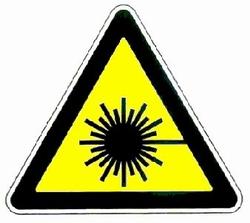 Solid State Laser (100 kW)
Solid State Laser (100 kW)
Will enable several shots of high-energy laser per minute on
fighters, bombers, transports, etc.
- Space-Based Infrared System—High
Will be key to enabling the transformational ability to defend
the United States against ballistic missile attack by greatly
enhancing ballistic missile detection.
Will provide the capability to look deeply and persistently into
areas that are inaccessible to current platforms due to political
restrictions, geographical constraints, or the technological
limitations of legacy systems. The continuous global access of SBR
and the extended-loiter capability of the UAV, combined with near
real-time data transfer to multiple relevant command and control
elements, will allow constant imaging or tracking of all relevant
mobile or fixed surface targets in any weather conditions in all
types of terrain as well as within urban areas.
- Space-Based Radio Frequency Energy Weapon
Would be a constellation of satellites containing high-power
radio-frequency transmitters that possess the capability to
disrupt/destroy/disable a wide variety of electronics and
national-level command and control systems. It would typically be
used as a non-kinetic anti-satellite weapon.
- Space-Based Space Surveillance System
Will be a constellation of optical sensing satellites to track
and identify space forces in deep space to enable offensive and
defensive counterspace operations.
Will enable a full spectrum exercise and training environment in
realistic “battlefield” conditions and augment existing
DoD range infrastructure and supports combined air, space, sea, and
land.
Would be a rapidly reusable orbital vehicle deployed from the
Space Operations Vehicle or Evolved Expendable Launch Vehicle that
is capable of executing a wide range of space control missions.
Would enable an on-demand spacelift capability with rapid
turn-around, multiple standardized payloads, space vehicle
maintenance, ISR, offensive and defensive counterspace, and space
surveillance capabilities. The Space Operations Vehicle would also
be one of the vehicles that would deploy the Common Aero
Vehicle.
- Space Tracking and Surveillance System
Will develop a series of interoperable research and development
satellites and supporting ground equipment for the detection and
tracking of ballistic missiles (formerly Space Based Infrared
System-Low).
- Supply Chain Common Operating Picture
Will integrate all supply chain information to provide a common
operational view of Air Force supply chain to the manager,
customers, and warfighting commanders. Establishes framework for
e-procurement and future enterprise ERP migration.
- Tactical Data Link Architecture Enhancements
When combined with Situational Awareness Data Link Gateway will
allow greater numbers of combat aircraft to access a wider variety
of Air Force and Navy platforms from active, guard and reserve
components to improve the sensor-to-shooter kill-chain
timeline.
Will embed a small tactical UAV squadron within Air Force
Special Operations Command to improve support to the special
operations missions and support to joint warfighting. Such smaller
UAVs include: the Desert Hawk, Force Protection Aerial Surveillance
System, the Pointer UAV, and the BatCam Micro UAV, which is part of
the Battlefield Air Operations Kit.
- Theater Air Control System
Will be an open-architecture, Defense Information Infrastructure
Common Operating Environment-compliant network capable of serving
all command and control mission applications.
- Theater Medical Planning and Control System
Would link theater surveillance, aeromedical
evacuation, planning, and response capabilities to regional,
coalition, and joint health support system.
- Time Critical Targeting Functionality ACTD
Will demonstrate the ability to provide commanders the manpower
and equipment necessary to more effectively strike critical fixed
and mobile targets.
- Transformational Communication Terminals
Key enabler of the Advanced Wideband System.
- Transformational Satellite
Will provide greatly expanded bandwidth and secure
communications.
- Unmanned Combat Aerial Vehicle
The Air Force is pursuing several UCAV platforms. They are
highly survivable and scaleable attack aircraft with selected
specific capabilities for lethal and non-lethal suppression of
enemy air defenses as well as strike missions. The Air Force is
also considering a limited near-term electronic attack capability
for them and studying the longer-term potential to integrate
directed energy and precision, all-weather capabilities.
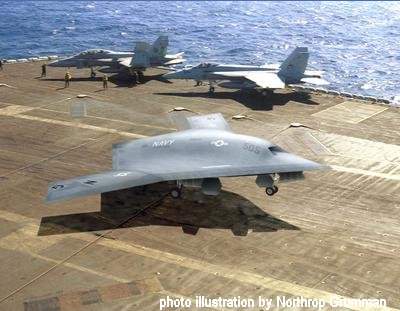
- Wide Area Search Autonomous Attack Miniature Munition
(WASAAMM)
Would be a miniature smart cruise missile with the ability to
loiter over and search for a specific target, significantly
enhancing time-critical targeting of moving or fleeting targets.
When the target is acquired, WASAAMM can either attack or relay a
signal to obtain permission to attack. Due to its very small size,
the WASAAMM has stealth qualities.
 Airborne 04.16.24: RV Update, Affordable Flying Expo, Diamond Lil
Airborne 04.16.24: RV Update, Affordable Flying Expo, Diamond Lil ANN's Daily Aero-Term (04.20.24): Light Gun
ANN's Daily Aero-Term (04.20.24): Light Gun Aero-News: Quote of the Day (04.20.24)
Aero-News: Quote of the Day (04.20.24) Aero-News: Quote of the Day (04.21.24)
Aero-News: Quote of the Day (04.21.24) ANN's Daily Aero-Term (04.21.24): Aircraft Conflict
ANN's Daily Aero-Term (04.21.24): Aircraft Conflict















